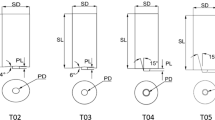Abstract
In this paper, A6005-T5 extruded aluminum alloy sheets which are used for floor, roof or wall panels of railroad vehicles were welded by the friction stir welding (FSW) and gas metal arc welding (GMAW) techniques. The mechanical characteristics including the tensile strength, micro-hardness and fatigue strength of the FSW joint were compared to those of the base metal and GMAW joints. In order to determine the relationship between the welding variables of FSW and the mechanical characteristics of the joint, the response function was derived using the least square method and the sensitivity analysis was performed. The rotational speed, welding speed and tilting angle of the welding tool were chosen as design variables. On the basis of the Plackett-Burman design table, eight different FSW experiments were done, and then the effects of design variables on the mechanical characteristics of the FSW joint were analyzed. The result showed that the welding speed has a most significant effect on the tensile and fatigue strength. In the case of the micro-hardness, the effect of the tilting angle was the biggest.
Similar content being viewed by others
References
Nadan, R., DebRoy, T. and Bhadeshia, H. K. D. H., “Recent advances in friction-stir welding — Process, weldment structure and properties,” Progress in Materials and Science, Vol. 53, No. 6, pp. 980–1023, 2008.
Thomas, W. M. and Nicholas, E. D., “Friction stir welding for the transportation industries,” Materials & Design, Vol. 18, No. 4–6, pp. 269–273, 1997.
Mishra, R. S. and Ma, Z. Y., “Friction Stir Welding and Processing,” Materials Science and Engineering: R: Reports, Vol. 50, No. 1–2, pp. 1–78, 2005.
Kim, H. T. and Kil, S. C., “Recent Research Trend of Friction Stir welding Process,” Proc. of the Korean Welding and Joining Society Spring Conf., p. 77, 2008.
Plackett, R. L. and Burman, J. P., “The design of optimum multifactorial experiments,” Biometrica, Vol. 33, No. 4, pp. 305–325, 1946.
Haug, E. J. and Arora, J. S., “Applied Optimum Design,” Wiley Interscience, New York, 1979.
Jung, S. P. and Park, T. W., “Development of the Optimization Design Module of a Brake System,” Transaction of Korean Society of Automotive Engineers, Vol. 16, No. 3, pp. 166–171, 2008.
Jung, S. P., Park, T. W., Yoon, J. W., Jun, K. J. and Chung, W. S., “Design Optimization of Spring of a Locking Nut Using Design of Experiments,” Int. J. Precis. Eng. Manuf., Vol. 10, No. 4, pp. 77–83, 2009.
Burden, R. L. and Faires, J. D., “Numerical Analysis, 7ed,” Brooks Cole, pp. 498–506, 2001.
Ericsson, M. and Sandstrom, R., “Influence of Welding Speed on the Fatigue of Friction Stir Welds, and Comparison with MIG and TIG,” International Journal of Fatigue, Vol. 25, No. 12, pp. 1379–1387, 2003.
James, M. N., Hattingh, D. G. and Bradley, G. R., “Weld Tool Travel Speed Effects on Fatigue Life of Friction Stir Welds in 5083 Aluminum,” International Journal of Fatigues, Vol. 25, No. 12, pp. 1389–1398, 2003.
Fujii, H., Cui, L., Maeda, M. and Nogi, K., “Effect of Tool Shape on Mechanical Properties and Microstructure of Friction Stir Welded Aluminum Alloys,” Material Science and Engineering A, Vol. 419, No. 1–2, pp. 25–31, 2006.
Elangovan, K. and Balasubramanian, V., “Influences of Pin Profile and Rotational Speed of the Tool on the Formation of Friction Stir Processing Zone in AA2219 Aluminum Alloy,” Materials Science and Engineering A, Vol. 459, No. 1–2, pp. 7–18, 2007.
Jung, S. P., Jun, K. J., Park, T. W. and Ahn, I. C., “An Optimum Design of a Gas Circuit Breaker Using Design of Experiments,” Mechanics Based Design of Structures and Machines, Vol. 36, No. 4, pp. 346–363, 2008.
Author information
Authors and Affiliations
Corresponding author
Rights and permissions
About this article
Cite this article
Kim, WK., Won, ST. & Goo, BC. A study on mechanical characteristics of the friction stir welded A6005-T5 extrusion. Int. J. Precis. Eng. Manuf. 11, 931–936 (2010). https://doi.org/10.1007/s12541-010-0113-1
Received:
Accepted:
Published:
Issue Date:
DOI: https://doi.org/10.1007/s12541-010-0113-1




